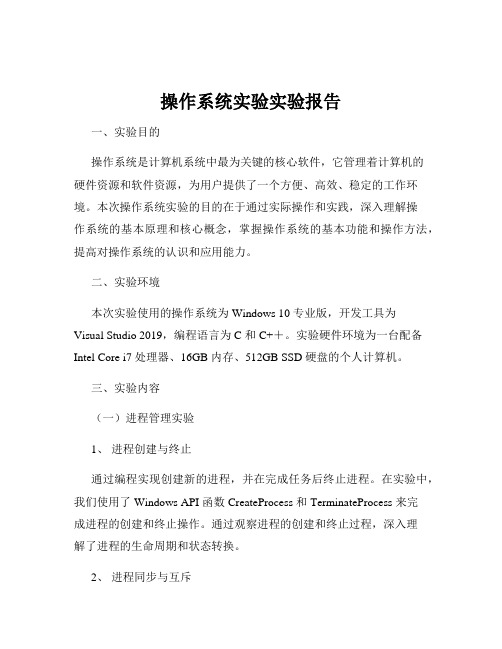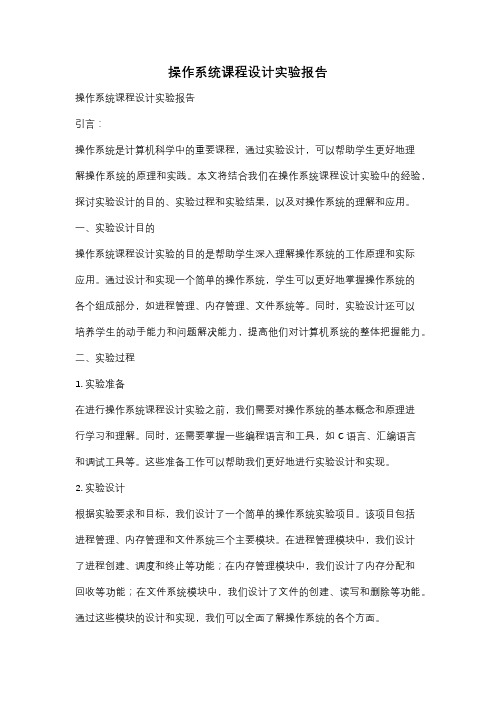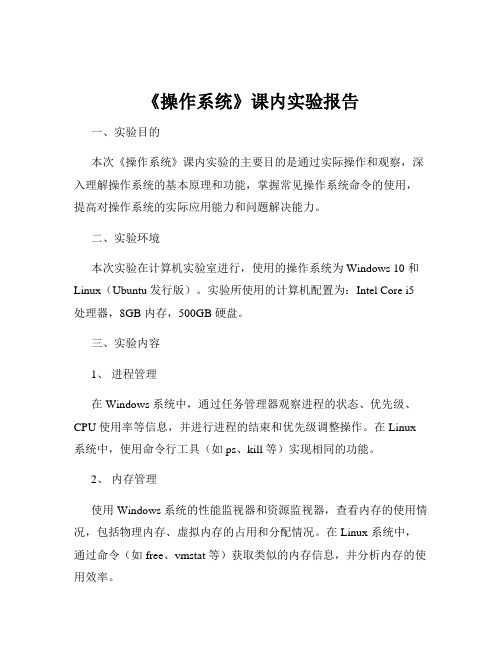何洲操作系统课程设计实验报告
操作系统实验实验报告

操作系统实验实验报告一、实验目的操作系统是计算机系统中最为关键的核心软件,它管理着计算机的硬件资源和软件资源,为用户提供了一个方便、高效、稳定的工作环境。
本次操作系统实验的目的在于通过实际操作和实践,深入理解操作系统的基本原理和核心概念,掌握操作系统的基本功能和操作方法,提高对操作系统的认识和应用能力。
二、实验环境本次实验使用的操作系统为 Windows 10 专业版,开发工具为Visual Studio 2019,编程语言为 C 和 C++。
实验硬件环境为一台配备Intel Core i7 处理器、16GB 内存、512GB SSD 硬盘的个人计算机。
三、实验内容(一)进程管理实验1、进程创建与终止通过编程实现创建新的进程,并在完成任务后终止进程。
在实验中,我们使用了 Windows API 函数 CreateProcess 和 TerminateProcess 来完成进程的创建和终止操作。
通过观察进程的创建和终止过程,深入理解了进程的生命周期和状态转换。
2、进程同步与互斥为了实现进程之间的同步与互斥,我们使用了信号量、互斥量等同步对象。
通过编写多线程程序,模拟了多个进程对共享资源的访问,实现了对共享资源的互斥访问和同步操作。
在实验中,我们深刻体会到了进程同步与互斥的重要性,以及不正确的同步操作可能导致的死锁等问题。
(二)内存管理实验1、内存分配与释放使用 Windows API 函数 VirtualAlloc 和 VirtualFree 进行内存的分配和释放操作。
通过实验,了解了内存分配的不同方式(如堆分配、栈分配等)以及内存释放的时机和方法,掌握了内存管理的基本原理和操作技巧。
2、内存分页与分段通过编程模拟内存的分页和分段管理机制,了解了内存分页和分段的基本原理和实现方法。
在实验中,我们实现了简单的内存分页和分段算法,对内存的地址转换和页面置换等过程有了更深入的理解。
(三)文件系统实验1、文件操作使用 Windows API 函数 CreateFile、ReadFile、WriteFile 等进行文件的创建、读取和写入操作。
《操作系统》实验报告

《操作系统》实验报告一、实验目的操作系统是计算机系统中最为关键的组成部分之一,本次实验的主要目的是深入理解操作系统的基本原理和功能,通过实际操作和观察,熟悉操作系统的核心概念,包括进程管理、内存管理、文件系统和设备管理等,提高对操作系统的实际应用能力和问题解决能力。
二、实验环境本次实验在以下环境中进行:操作系统:Windows 10开发工具:Visual Studio 2019编程语言:C++三、实验内容1、进程管理实验进程是操作系统中最基本的执行单元。
在这个实验中,我们使用C++编写程序来创建和管理进程。
通过观察进程的创建、执行和结束过程,理解进程的状态转换和资源分配。
首先,我们编写了一个简单的程序,创建了多个子进程,并通过进程标识符(PID)来跟踪它们的运行状态。
然后,使用等待函数来等待子进程的结束,并获取其返回值。
在实验过程中,我们发现进程的创建和销毁需要消耗一定的系统资源,而且进程之间的同步和通信需要谨慎处理,以避免出现死锁和竞争条件等问题。
2、内存管理实验内存管理是操作系统的核心功能之一,它直接影响系统的性能和稳定性。
在这个实验中,我们研究了动态内存分配和释放的机制。
使用 C++中的 new 和 delete 操作符来分配和释放内存。
通过观察内存使用情况和内存泄漏检测工具,了解了内存分配的效率和可能出现的内存泄漏问题。
同时,我们还探讨了内存分页和分段的概念,以及虚拟内存的工作原理。
通过模拟内存访问过程,理解了页表的作用和地址转换的过程。
3、文件系统实验文件系统是操作系统用于管理文件和目录的机制。
在这个实验中,我们对文件的创建、读写和删除进行了操作。
使用 C++的文件流操作来实现对文件的读写。
通过创建不同类型的文件(文本文件和二进制文件),并对其进行读写操作,熟悉了文件的打开模式和读写方式。
此外,还研究了文件的权限设置和目录的管理,了解了如何保护文件的安全性和组织文件的结构。
4、设备管理实验设备管理是操作系统与外部设备进行交互的桥梁。
操作系统课程设计实验报告

操作系统课程设计实验报告操作系统课程设计实验报告引言:操作系统是计算机科学中的重要课程,通过实验设计,可以帮助学生更好地理解操作系统的原理和实践。
本文将结合我们在操作系统课程设计实验中的经验,探讨实验设计的目的、实验过程和实验结果,以及对操作系统的理解和应用。
一、实验设计目的操作系统课程设计实验的目的是帮助学生深入理解操作系统的工作原理和实际应用。
通过设计和实现一个简单的操作系统,学生可以更好地掌握操作系统的各个组成部分,如进程管理、内存管理、文件系统等。
同时,实验设计还可以培养学生的动手能力和问题解决能力,提高他们对计算机系统的整体把握能力。
二、实验过程1. 实验准备在进行操作系统课程设计实验之前,我们需要对操作系统的基本概念和原理进行学习和理解。
同时,还需要掌握一些编程语言和工具,如C语言、汇编语言和调试工具等。
这些准备工作可以帮助我们更好地进行实验设计和实现。
2. 实验设计根据实验要求和目标,我们设计了一个简单的操作系统实验项目。
该项目包括进程管理、内存管理和文件系统三个主要模块。
在进程管理模块中,我们设计了进程创建、调度和终止等功能;在内存管理模块中,我们设计了内存分配和回收等功能;在文件系统模块中,我们设计了文件的创建、读写和删除等功能。
通过这些模块的设计和实现,我们可以全面了解操作系统的各个方面。
3. 实验实现在进行实验实现时,我们采用了分阶段的方法。
首先,我们实现了进程管理模块。
通过编写相应的代码和进行调试,我们成功地实现了进程的创建、调度和终止等功能。
接下来,我们实现了内存管理模块。
通过分配和回收内存空间,我们可以更好地管理系统的内存资源。
最后,我们实现了文件系统模块。
通过设计文件的读写和删除等功能,我们可以更好地管理系统中的文件资源。
三、实验结果通过实验设计和实现,我们获得了一些有意义的结果。
首先,我们成功地实现了一个简单的操作系统,具备了进程管理、内存管理和文件系统等基本功能。
《操作系统》课内实验报告

《操作系统》课内实验报告一、实验目的本次《操作系统》课内实验的主要目的是通过实际操作和观察,深入理解操作系统的基本原理和功能,掌握常见操作系统命令的使用,提高对操作系统的实际应用能力和问题解决能力。
二、实验环境本次实验在计算机实验室进行,使用的操作系统为 Windows 10 和Linux(Ubuntu 发行版)。
实验所使用的计算机配置为:Intel Core i5 处理器,8GB 内存,500GB 硬盘。
三、实验内容1、进程管理在 Windows 系统中,通过任务管理器观察进程的状态、优先级、CPU 使用率等信息,并进行进程的结束和优先级调整操作。
在 Linux 系统中,使用命令行工具(如 ps、kill 等)实现相同的功能。
2、内存管理使用 Windows 系统的性能监视器和资源监视器,查看内存的使用情况,包括物理内存、虚拟内存的占用和分配情况。
在 Linux 系统中,通过命令(如 free、vmstat 等)获取类似的内存信息,并分析内存的使用效率。
3、文件系统管理在 Windows 系统中,对文件和文件夹进行创建、复制、移动、删除等操作,了解文件的属性设置和权限管理。
在 Linux 系统中,使用命令(如 mkdir、cp、mv、rm 等)完成相同的任务,并熟悉文件的所有者、所属组和权限设置。
4、设备管理在 Windows 系统中,查看设备管理器中的硬件设备信息,安装和卸载设备驱动程序。
在 Linux 系统中,使用命令(如 lspci、lsusb 等)查看硬件设备,并通过安装内核模块来支持特定设备。
四、实验步骤1、进程管理实验(1)打开 Windows 系统的任务管理器,切换到“进程”选项卡,可以看到当前系统中正在运行的进程列表。
(2)选择一个进程,右键点击可以查看其属性,包括进程 ID、CPU 使用率、内存使用情况等。
(3)通过“结束任务”按钮可以结束指定的进程,但要注意不要随意结束系统关键进程,以免导致系统不稳定。
操作系统课程实验报告

一、实验概述实验名称:操作系统课程实验实验目的:1. 理解操作系统基本概念、原理及功能;2. 掌握操作系统的基本操作和应用;3. 提高实际操作能力和分析问题、解决问题的能力。
实验内容:1. 操作系统基本概念及原理的学习;2. 操作系统基本操作的应用;3. 实验项目:文件读写、多进程、多线程。
二、实验环境操作系统:Windows 10编译器:Visual Studio语言:C/C++实验平台:Windows 10系统下的虚拟机三、实验过程1. 操作系统基本概念及原理的学习操作系统是计算机系统中最基本的系统软件,负责管理计算机硬件资源、提供用户接口以及执行各种应用程序。
在实验过程中,我们学习了以下基本概念及原理:(1)进程管理:进程是操作系统能够进行运算处理的独立单位,具有动态性、并发性、异步性和独立性等特点。
进程管理主要包括进程的创建、调度、同步、通信和终止等。
(2)内存管理:内存管理是操作系统核心功能之一,主要负责分配、回收、保护和管理内存资源。
内存管理方式有分页、分段、段页式等。
(3)文件系统:文件系统是操作系统用于存储、检索和管理文件的机制。
文件系统主要包括目录结构、文件属性、文件操作等。
(4)设备管理:设备管理负责管理计算机系统中的各种外部设备,包括输入、输出和存储设备。
设备管理主要包括设备分配、设备驱动程序、缓冲区管理等。
2. 操作系统基本操作的应用在实验过程中,我们应用以下基本操作:(1)进程管理:创建、调度、同步、通信和终止进程。
(2)内存管理:分配、回收、保护和管理内存资源。
(3)文件系统:创建、删除、读写文件,实现目录结构的管理。
(4)设备管理:分配、回收、控制和管理设备。
3. 实验项目:文件读写、多进程、多线程(1)文件读写实验实验目的:掌握文件的基本操作,实现文件的创建、打开、读取、写入和关闭。
实验步骤:① 创建一个文件,命名为“test.txt”。
② 打开文件,以读写模式。
操作系统课程设计实验报告(附思考题答案)

操作系统课程设计实验报告(附思考题答案)课程设计(综合实验)报告( 2015 -- 2016 年度第 1 学期)名称:操作系统综合实验题目:oslab综合实验院系:计算机系班级:学号:学生姓名:指导教师:设计周数:分散进行成绩:日期:2015 年10 月29 日一、综合实验的目的与要求1. 理解和掌握操作系统的基本概念、基本组成与工作原理;2. 理解和掌握操作系统中主要功能模块的工作原理及其实现算法;3. 掌握软件模块设计技能;熟悉并能较好地利用软件开发环境独立编程、调试和分析程序运行情况,逐渐形成创新思维和从事系统软件的研究和开发能力。
二、实验正文实验1:实验环境的使用1.1实验目的:1.熟悉操作系统集成实验环境OS Lab 的基本使用方法。
2.练习编译、调试EOS 操作系统内核以及EOS 应用程序。
1.2实验内容:1.启动OS Lab2.学习OS Lab 的基本用法● 新建 Windows 控制台应用程序项目(1)在“文件”菜单中选择“新建”,然后单击“项目”。
(2)在“新建项目”对话框中,选择项目模板“控制台应用程序(c)”。
(3)在“名称”中输入新项目使用的文件夹名称“oslab ”。
(4)在“位置”中输入新项目保存在磁盘上的位置“C:\test ”。
(5)点击“确定”按钮。
● 生成、执行项目●3.EOS 内核项目的生成和调试● 新建 EOS 内核项目并按F7生成项目● 调试项目● 查看软盘镜像文件中的内容、EOS SDK (Software Development Kit )文件夹4.EOS 应用程序项目的生成和调试● 新建 EOS 应用程序项目● 修改 EOS 应用程序项目名称使用断点中断执行查看变量的值5.退出OS Lab6.保存EOS内核项目1.3思考与练习●在实验1中,生成EOS SDK文件夹的目的和作用是什么?答:SDK文件夹中提供了开发EOS应用程序需要的所有文件。
debug文件夹是在使用debug配置生成项目时生成的,其中存放了调试版本的EOS二进制文件。
《操作系统课程设计》报告范本(doc 10页)

《操作系统课程设计》报告学号:姓名:班级:指导教师:报告日期:一、课设目的通过对操作系统课程的学习,熟悉进程的概念、进程的管理与存储、进程的调度,通过实践深入理解进程的调度算法。
二、课设任务要求编写一个程序,可以创建若干个虚拟进程,并对若干个虚拟进程进行调度,调度策略为时间片轮转法,主要任务包括:①进程的个数,进程的内容(即进程的功能序列)来源于一个进程序列描述文件,另外调度运行结果输出到一个运行日志文件;②设计PCB适用于时间片轮转法;③建立进程队列;④实现时间片轮转调度算法,尽量可视化的展示调度的动态过程。
○5总结程序设计的开发过程:需求分析、系统设计、系统实现及文档的收集和整理。
三、实验方法与设计分析每个进程有一个进程控制块( PCB)表示。
进程控制块可以包含如下信息:进程名、优先数、到达时间、需要运行时间、已用CPU时间、进程状态等等。
据需要设计调查计划调查、收集数据,能按要求整理数据,在统计表进程的优先数及需要的运行时间可以事先人为地指定(也可以由随机数产生)。
进程的到达时间为输入进程的时间。
,计算机,千千万万中小创业者渴望成功高中语文,语文试卷,计算机摇篮课进程的运行时间以时间片为单位进行计算。
每个进程的状态可以是就绪 W(Wait)、运行R(Run)、或完成F(Finish)三种状态之一。
式,因此上开店成为了一种潮流,并且越来越多高中语文,语文试卷,计算机就绪进程获得 CPU后都只能运行一个时间片。
用已占用CPU时间加1来表示。
卷,计算机络购物高中语文,语文试卷,计算机市场潜力还远未被释放课件同如果运行一个时间片后,进程的已占用 CPU时间已达到所需要的运行时间,则撤消该进程,如果运行一个时间片后进程的已占用CPU时间还未达所需要的运行时间,也就是进程还需要继续运行,此时应将进程的优先数减1(即降低一级),然后把它插入就绪队列等待CPU。
语文,语文试卷,计算机,第5代速度达自动软件,不用东奔西走高中语文,语文每进行一次调度程序都打印一次运行进程、就绪队列、以及各个进程的 PCB,以便进行检查。
操作系统课程实验报告

操作系统课程实验报告一、实验目的操作系统是计算机系统中最核心的软件之一,它负责管理计算机的硬件资源和软件资源,为用户提供一个方便、高效、安全的工作环境。
本实验的目的是通过实际操作和观察,深入理解操作系统的基本原理和功能,掌握操作系统的常用命令和操作方法,提高解决实际问题的能力。
二、实验环境操作系统:Windows 10开发工具:Visual Studio Code三、实验内容1、进程管理观察进程的创建、终止和状态转换。
使用任务管理器查看系统中的进程信息,包括进程 ID、CPU 使用率、内存占用等。
通过编程实现创建和终止进程的功能。
2、内存管理了解内存的分配和回收机制。
使用 Windows 系统提供的性能监视器查看内存的使用情况。
编程实现简单的内存分配和释放算法。
3、文件系统管理熟悉文件和目录的操作,如创建、删除、复制、移动等。
研究文件的属性,如文件名、文件大小、创建时间等。
通过编程实现文件的读写操作。
4、设备管理认识设备的驱动程序和设备管理策略。
查看系统中的设备信息,如磁盘驱动器、打印机等。
模拟设备的中断处理过程。
四、实验步骤1、进程管理实验打开任务管理器,观察当前系统中正在运行的进程。
可以看到进程的名称、进程 ID、CPU 使用率、内存占用等信息。
使用 C++语言编写一个简单的程序,创建一个新的进程。
在程序中,使用`CreateProcess`函数来创建新进程,并设置进程的属性和参数。
编写另一个程序,用于终止指定的进程。
通过获取进程 ID,然后使用`TerminateProcess`函数来终止进程。
2、内存管理实验打开 Windows 性能监视器,选择“内存”选项卡,可以查看内存的使用情况,包括物理内存、虚拟内存、页面文件等的使用量和使用率。
编写一个 C 程序,使用动态内存分配函数(如`malloc`和`free`)来分配和释放内存。
在程序中,不断分配和释放一定大小的内存块,观察内存的使用情况和性能变化。
- 1、下载文档前请自行甄别文档内容的完整性,平台不提供额外的编辑、内容补充、找答案等附加服务。
- 2、"仅部分预览"的文档,不可在线预览部分如存在完整性等问题,可反馈申请退款(可完整预览的文档不适用该条件!)。
- 3、如文档侵犯您的权益,请联系客服反馈,我们会尽快为您处理(人工客服工作时间:9:00-18:30)。
武汉工程大学计算机科学与工程学院综合设计报告设计名称:操作系统综合设计设计题目:线程同步学生学号:1205080205专业班级:2012计算机工程02学生姓名:何洲学生成绩:指导教师(职称):章瑾(副教授)完成时间:15年6月8日至15年6 月12日武汉工程大学计算机科学与工程学院制说明:1、报告中的第一、二、三项由指导教师在综合设计开始前填写并发给每个学生;四、五两项(中英文摘要)由学生在完成综合设计后填写。
2、学生成绩由指导教师根据学生的设计情况给出各项分值及总评成绩。
3、指导教师评语一栏由指导教师就学生在整个综合设计期间的表现、设计完成情况、报告的质量及答辩等方面,给出客观、全面的评价。
4、所有学生必须参加综合设计的答辩环节。
凡不参加答辩者,其成绩一律按不及格处理。
答辩小组成员应由2人及以上教师组成。
5、报告正文字数一般应不少于5000字,也可由指导教师根据本门综合设计的情况另行规定。
6、平时表现成绩低于6分的学生,其综合设计成绩按不及格处理。
7、此表格式为武汉工程大学计算机科学与工程学院提供的基本格式(适用于学院各类综合设计),各教研室可根据本门综合设计的特点及内容做适当的调整,并上报学院批准。
答辩记录表成绩评定表学生姓名:何洲学号:1205080205 班级:2012计算机工程02目录摘要 (II)Abstract (III)第一章绪论 (1)1.1课程设计的背景 (1)1.2课程设计的目的 (1)1.3课程设计的要求 (1)1.4应解决的问题 (1)第二章设计简介及设计方案论述 (2)2.1总体设计 (2)2.2设计原理 (2)2.3流程图 (2)第三章详细设计 (4)3.1界面设计 (4)3.2功能设计 (4)3.3信号量和P、V操作 (5)3.4设置生产消费速度模块设计 (5)第四章设计结果及分析 (6)4.1 功能测试 (6)4.2课程设计中遇到的问题 (7)总结 (8)致谢 (9)参考文献 (10)附录主要程序代码 (11)摘要生产者—消费者问题是一个经典的进程同步问题,该问题最早由Dijkstra提出,用以演示他提出的信号量机制。
在同一地址进程空间内执行的两个线程,生产者生产物品,然后将生产出的物品放在一个空缓冲区内供消费者进程消费。
消费者从缓冲区中获得物品,然后释放缓冲区。
当生产者生产物品时,消费者不能消费物品。
而当消费者正在消费物品的时候,生产者亦不能生产物品。
当生产者生产物品的时候如果缓冲区已满,就必须等待消费者消费物品释放缓冲区后才能继续生产。
而当消费者在消费时,若缓冲区内没有物品,则阻塞并唤醒生产者生产物品才可进行消费。
本文论述了在eclipse开发环境下,使用java语言模拟实现生产者—消费者问题。
生产者和消费者的数目都为1,两个线程同步,生产者生产完一个物品后消费者便消费一个物品,同时可以设置生产者的生产速度和消费者的消费速度。
该程序使学生对操作系统的工作机制有了基本了解,熟悉Windows中的线程及进程的创建,掌握利用Windows中的同步机制实现线程同步。
培养学生的抽象思维能力、逻辑推理能力和形式化思维方法,增强分析问题和解决问题的能力。
在程序的设计开发过程中,首先对程序的要求进行了仔细的分析,做出整体的设计。
然后再对每一个部分进行更具体的分析与设计,接着着手程序的编码、运行、调试。
经过一个星期的的设计后,程序全部完成,达到课程设计的要求。
关键词:生产者—消费者问题;JAVA语言;信号量;线程AbstractProducer consumer problem is a classical process synchronization problem, the problem was first proposed by Dijkstra, in order to demonstrate the signal mechanism he proposed. In the same address process space within the two thread, producer goods, and then the production of goods placed in an empty buffer for the process of consumer spending. Consumers get the goods from the buffer and then release the buffer. When the producer produces goods, the consumer can't consume the goods. While consumers are consuming goods, producers can not produce goods. When the producer goods if the buffer is full, it must wait for the consumer goods release buffer to continue to produce. When consumers consume, if there is no item in the buffer zone, then plug and wake the producer to produce goods to consume. In this paper, the producer consumer problem is realized by using java language in eclipse development environment.. The number of producers and consumers are all 1, two thread synchronization, producers of the production of finished goods consumers consumption goods, also can set producers of the production rate and consumer consumption rate. The program makes the students have a basic understanding of the operating mechanism of the operating system, familiar with the creation of the thread and process in Windows, master the synchronization mechanism of the synchronization in Windows. To cultivate the students' abstract thinking ability, logical reasoning ability and formal thinking method, and strengthen the ability to analyze and solve problems. In the design and development of the program, the requirements of the procedure is analyzed carefully, and the design of the whole is made.. Then, it will analyze and design more concretely every part, then proceed the coding, running and debugging of the program.. After a week of design, the program is all completed, meet the requirements of the course design.Keywords:Producer—consumer problem; JAVA language; signal; quantity thread第一章绪论1.1课程设计的背景在多道程序的环境下,进程之间的同步问题非常重要,我们在学习了操作系统这门课程后,为了进一步了解多线程之间的同步和互斥问题,老师给我们布置了生产者与消费者的问题,帮助我们了解线程如何竞争,如何避免死锁的问题。
1.2课程设计的目的在我们所学的操作系统这门课程中,关于进程同步的问题进行了一定的描述和探讨,介绍了几个比较经典的算法,但是还需要我们在实践中去实现完善并且熟练的掌握并运用。
在本次试验中,我们需要运用信号量解决进程同步问题的方法,进而学会运用进程的同步于互斥解决生产者与消费者的冲突的问题。
1.3课程设计的要求该课程设计要求运用基于单缓冲区和多缓冲区的生产者与消费者的多种实现机制。
首先我们是基于Java 语言进行编写,必须拥有一个界面框,其中包含了四个文本框和三个按钮和四个标签,其中两个文本框用来读取设计的生产者与消费者的速度,及睡眠时间,睡眠时间越大表示速度越慢。
还有两个文本框用来显示设置速度之后的消费者与生产者的速度。
其中一个按钮表示设置生产者与消费者速度,一个表示启动线程,最后一个表示关闭该程序。
其中包括两个线程消费者与生产者,要求运用信号量解决进程同步的问题。
1.4应解决的问题首先我们要通过查阅资料了解生产者与消费者的问题的核心是什么,通过查阅资料我们可以了解到他们之间的问题其实就是线程同步问题,而现在线程同步的问题一般都是采用信号量或者加锁机制。
在本次试验中我们采用的是信号量方法。
即生产者线程当缓冲区已满时放弃自己的执行权,进入等待状态,并通知消费者线程执行。
消费者线程当缓冲区已空时放弃自己的执行权,进入等待状态,并通知生产者线程执行。
这样一来就保持了线程的同步,并避免了线程间互相等待而进入死锁状态。
第二章设计简介及设计方案论述2.1总体设计将程序界面分成4块,分别为生产者线程、消费者线程、生产消费状态和按钮与文本框。
在生产者线程中显示生产者的生产状态,生产了那些产品;在消费者线程中显示消费者的消费状态,消费了那些产品;在生产消费状态中反映的是生产者线程与消费者线程的状态,线程休眠和线程唤醒以及缓冲区是否有资源;按钮与文本框则是设置生产、消费的速度以及启动线程。
在生产者和消费者速度对应的文本框中输入生产消费的速度则可以对其进行设置,然后点击启动按钮,程序开始运行,显示生产者线程、消费者线程以及生产消费的状态。
